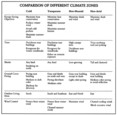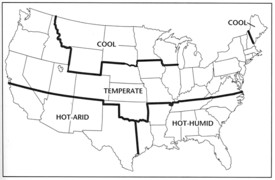 |
There are four main climate zones in the United States: cool, temperate, hot-arid, and hot-humid. Each zone has different needs and therefore requires different techniques for climate amelioration.
The cool zone has very cold winters and hot summers with a wide range of temperatures, from -30 degrees F to over 100 degrees F in summer. Persistent prevailing winds usually come from the northwest and the southwest. In the cool zone the days are short in winter and the sun is very low in the sky.
The temperate zone has cool and hot seasons that are about the same length. Temperatures are not as extreme as in the cool regions. Seasonal winds blow from the northwest and south. Temperate zones have lots of rain and high humidity. The summers may be hot, heavy, and uncomfortable.
The hot-arid zone is dry, clear, and sunny. The summers are long and hot. The nights cool rapidly as heat radiates from the ground into the clear skies. Winds are generally along an east-west axis, with variations between night and day.
The hot-humid zone is warm and wet. Winds are variable in direction and velocity. Hurricanes are common, their winds often from the east or southeast.
By understanding the subtle differences among zones, you can use supplemental energy-saving techniques in the most effective way. In the hot-humid zone, for example, large trees can be used for protection from the hot western setting sun; however, they should be far enough away from the building so that a hurricane will not blow them down on the house. Also, low trees should be used on the east exposure because of the prevailing hurricane winds.
 Cool Zone — Overhead view: 1. Evergreen windbreak; 2. Garage and unheated storage on north and east sides; 3. Cool summer spot under grove on east side; 4. Outdoor living areas on south and west paved for maximum heat retention; 5.Glass areas on south; 6. Tree to block summer sun; 7. Protective wing wall; 8. Tree to block late afternoon sun. Side view: 1. Roof overhang; 2. Shrubs for extra insulation; 3. Earth berm with evergreen windbreak on northwest; 4. Protective wind shadow. |
Cool Zones
In cold areas, keeping warm uses more energy than summer cooling and is the major thrust of energy-saving techniques. Some concern, however, should be given to relief from summer heat. Heavy insulation is mandatory.
Windows on the south should let in sunlight for warmth in winter. On the northwest, berms or evergreen windscreens, or both, should give protection from the prevailing winter wind. Land forms, walls and fences may be used to provide sun pockets and barriers.
For the longest seasonal use, outdoor living areas are best placed on the southern exposure. Deciduous trees or overhangs on the south may be needed for some protection from the summer noonday sun. In some locations, protection on the west from the hot, low summer sun may be necessary. A tree or even a trellis with honeysuckle will work.
 1. Evergreen windbreak; 2. Garage and unheated storage on north and east sides; 3. Cool summer grass area under trees; 4. Grass is cooler than paving on south side; 5. Deciduous trees on south and west for both summer shade and winter sun; 6. Channel summer winds for cooling inside and out; 7. Protective wing wall. |
Temperate Zones
It is necessary to conserve heat in winter as well as to provide cooling and occasional dehumidifying in summer. Because of the milder climate, protected outdoor areas in the temperate zone can be used for a longer season than in cold regions. Outdoor living areas should be on the south and southwest, protected from cold north and northwest winds. Tall deciduous trees should be used on the south and west exposures to provide maximum cooling and to allow penetration of warming winter sun.
Trees, landforms, walls and fences can provide protection from cold winter winds where they are strong. Wind shadows should be created to protect the north side of the building and also to protect doorways from winter winds. Wall insulation is not as common here as in northern climates, so winter wind protection is most important.
Because the summers tend to be hot, outdoor areas should be designed to take advantage of prevailing summer breezes, which usually come from a slightly different direction than winter winds. Ideally, these warm-season breezes should be channeled through the house for cooling, where possible.
 1. Channel prevailing wind to cool house; 2. Use pool upwind to humidify air; 3. Outdoor living area on east; 4. Grass near house for coolness; 5. Southern exposure shaded by trees; 6. Trees for shade and humidity; 7. Winter hot pocket against fence, facing south to catch sun. |
Hot-Arid Zone
Keeping cool during the day and warm at night are the main goals of climate modification in hot-arid regions. Outdoor living areas should be to the east; the building will provide shade during hot afternoons.
East and west windows should be shaded. Glass walls should face north. South-facing windows need protection with a large overhang, deciduous trees or trellises. Excessive glare from the outdoors sun area can be reduced by planting grass and shrubs near the building. Underplanting near the house should be thick to insulate and hold humidity.
Shade roof and parking areas with overhanging trees. The roof should be light to reflect heat away from the building, and the parking areas should be surfaced with a medium-colored material that neither absorbs heat (like blacktop), nor reflects it (like white stone).
Cooling daytime breezes should be maximized by increasing their speed with wind funnels. In some desert areas, however, winds are unpleasantly strong; in such places funnels should not be considered. There should instead be protected areas for sitting. For houses that don’t cool off fast enough at night, the window curtains should be left open for maximum solar heat loss after dark. When the curtains are left open, heat will quickly radiate through the glass into the cloudless, star-studded black sky.
Evaporation from lakes, pools, or fountains will provide further cooling and humidifying if they’re upwind from the building.
 Overhead and side views: 1. Outdoor living area on east under trees; 2. Use low growing ground cover, grass, or paving instead of shrubs to retard dampness; 3. Trees and trellis on south side; 4. Prevailing wind directed around and through house for cooling and drying; 5. Hot outdoor patio, paved for winter use; 6. High-headed trees to shade roof, but tall enough to good air circulation underneath. CAUTION: In areas with hurricanes, use lower trees and more trellises near the house. |
Hot-Humid Zone
Shade and movement of air through the site are the most important considerations for this zone. Outdoor living areas should be on the east or north side of the building. Plantings should shade both the structure and the outdoor living areas. East and west windows should be shaded. South windows should have overhangs for protection from trees. On old southern plantation houses, a wide wraparound porch shaded the windows, which also allowed them to be kept open for cool breezes during rainstorms.
Trees should be high-headed to allow breezes beneath. Movement of air is important not only for cooling, but also for evaporation of the ever-present moisture and to lessen the resulting growth of mildew.
Wind funnels should be created with low trees, shrubs and walls to direct breezes around the house and possibly through the house and outdoor living areas. Underplantings near the buildings should be kept very low for better air circulation and to minimize dank areas and mildew. Sunny areas should be planted with grass or low ground cover to absorb solar heat, rather than to reflect it onto the walls and into the windows. Shaded areas may be paved, preferably with a medium-color paving, such as brick.
 Comparison of Climate Zones. CLICK TO ENLARGE. |
A protected winter sun pocket may be created by paving and fencing a small area to catch the winter sun and extended outdoor use.
Credit: www.mothersgarden.net




























